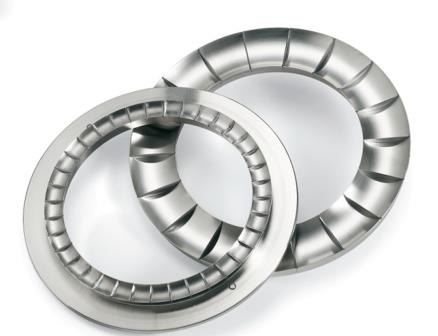Accurate and Fast Bulk Density Test Method
July 18, 2016

Perhaps the number one test currently in use for bulk solids characterization is a tapped bulk density test. This simplistic test has been used for decades. Inexpensive and quick, it supplies a value that is calculated as the difference in volume from a container or graduated cylinder that is filled with powder (fill density) and then tapped a certain number of times (tapped bulk density).
The premise is simple: The greater the change in volume, the denser is the material and the harder it will be to flow. The tapped bulk density value can also be used to calculate values for Carr Index and Hausner Ratio, which are standard analytical calculations for characterization of bulk solids.
While tapped bulk density testing has been the “go to” test for bulk solids characterization for many years, it can be subjective. The issue is not with the bulk density measurement, but with the test method itself. The operator manually taps a beaker or graduated cylinder a certain number of times (100 and 150 are common choices). The operator then gages the change in bulk density visually. And therein lies the subjectivity of the result. If this value is then used to calculate a Carr Index or Hausner Ratio, these values are equally subjective. And, there are other considerations.
A tapped bulk density measurement gives minimal information on the flow characteristics of powders. Nor does it take into account environmental changes that can affect the flowability of powders during the production cycle. Its price point makes it attractive, which is why it has been used in the bulk solids industry forever. But when flow problems crop up, there needs to be more comprehensive information on the flow characteristics of the materials beside just a tapped bulk density measurement.
There is a single solution for both providing timely, accurate bulk density test data and for acquiring comprehensive flow behavior information…all acquired quickly and with minimal effort by the operator.
Annular Shear Cell and Bulk Density Test Methods
The solution is provided by an annular shear cell, which has seen industrial use since the 1960s. It is the tried and true test method for full characterization of bulk solids flow behavior in gravity discharge from a containment vessel. By measuring the inter-particle friction of a small powder sample tested over a defined series of consolidation stresses (known as the Flow Function Test), a full gamut of information on the material is provided including flow behavior, bulk density, arching dimension, rat-hole diameter and internal friction angle.
See FIGURE 1
This information provides a comprehensive data set for characterizing the material. The shear cell provides clear numerical values for powder yield strength that can be further analyzed to define a material’s flow capabilities.
See FIGURE 2
While the shear cell can provide bulk density information as part of the general Flow Function test, it is sometimes desirable to provide a quick assessment of bulk density by itself. For this capability, a standalone test utilizing a flat wall lid on the shear cell provides a bulk density measurement in 100 seconds. The advantage of using the shear cell vs. the tap tester is the scientific nature of the results. There is no human interpretation and, thus, no human error or subjectivity. The data results are accurate and repeatable. For those accustomed to Carr Index and Hausner Ratio results, comparable information is given with a Compressibility Index and Compressibility Ratio calculations.
See FIGURE 3
Interpretation of Data
The shear cell provides the complete solution for accurate, timely bulk density tests, with the added bonus of comprehensive flow function data. While the more detailed flow function data can be used to characterize the production batch, the standalone bulk density measurement can be used to quickly gage the product for QA/QC purposes in a little over a minute and half. One fast way of gaging a powder is to calculate the difference between the fill bulk density and the final bulk density. If the difference is 30-50%, then this is an indication of a material that will become hard to flow. That is, it will self-compact or consolidate during processing.
A typical data graph for a bulk density measurement would look like this:
See FIGURE 4
As an example of this type of self-compaction, think of filling your hand with granulated sugar. Now, squeeze the sugar with your hands. You will not be able to compact the material. The particles are too hard and too large. Now, try doing this with cocoa. The material will compact, thus having a higher bulk density from when you initially filled your hands.
The graph and data in Figure 4 show this behavior for a sugar and a flour. You can clearly see the sugar has virtually no change in bulk density, while the flour is showing a change from fill bulk density to final bulk density of 30%.
In a practical, real world application, the bulk density data would be used for fill weights, tablet making, or to gage how a material has become harder to flow. If bulk density were to increase because of environmental conditions, incorrect blending, out of spec raw materials, etc., the bulk density test would quickly identify the problem. Steps can then be taken to bring the bulk density levels back to an acceptable level.
Conclusion
Bulk density testing has certainly been the test of choice in the bulk solids industry for many years, but has provided very limited flow data information. Through the use of an annular shear cell, more comprehensive flow data can be collected and analyzed. For a fast QA/QC test during a production run, the shear cell provides a standalone bulk density test with accurate, timely and repeatable measurements that can be used reliably during the production cycle. This is an important distinction. No longer is it just up to a simple tapped bulk density test to determine whether production moves forward or halts. Now you can see why the versatile annular shear cell with both flow function and standalone bulk density tests can become the method of choice in the bulk solids industry.
Vinnie Hebert, is sales manager – Powder Flow Tester at Brookfield AMETEK Inc., Middleboro, MA. For more information, call 800-628-8139, email [email protected], or visit www.brookfieldengineering.com.
For related articles, news, and equipment reviews, visit our Instrumentation & Control Equipment Zone
Click here for a List of Instrumentation & Control Equipment Manufacturers
You May Also Like

